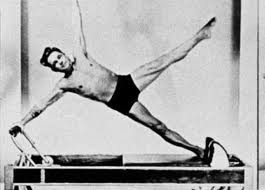The Hundred is one of Pilates most basic, yet important exercises.
The Hundred is a classic Pilates Exercise. It builds strength, stamina and coordination. Begin by lying on your back with knees bent. Lift your head and shoulders up and forward. Press your arms long at your sides, reaching out just above your hips, and extend your legs out. Scoop your abdominals in and up. You're in position, but do you really understand the exercise you're about to do?
 Why is it called The Hundred?
Why is it called The Hundred? During this breathing and circulation exercise, you are going to take ten FULL breaths. While you are doing that breathing, you are lengthening, scooping, and vigorously pumping your arms --five pumps on each inhale and five on each exhale. You'll do one hundred pumps with those arms before the exercise is over! After one hundred pumps, you are warmed up and ready for your Pilates workout!
What are the benefits of The Hundred? The Hundred is the main warm-up exercise in Pilates. The Hundred is always done at the beginning of every Pilates workout -- whether it's on the mat, the reformer, or another apparatus. It is a coordination of breathing and movement, using the control of your powerhouse, that increases your circulation and prepares you for what's to come in your session. When done properly, The Hundred incorporates all of the principles of Pilates that you'll use during the rest of your session, and it exercises your whole body! You will definitely feel the work in your abdominals, but you are also extending your arms and legs and lengthening your spine at the same time.
What if I cannot lengthen my legs out straight? Many people find extending the legs straight out while doing The Hundred to be a challenge. Try working up to this point, starting with "table top" legs - keeping the legs bent at ninety degrees. Once this becomes easy, reach legs straight up to the ceiling, then gradually lower the legs each time you do the exercise after that. Don't try to reach the legs straight out before you're ready, you may strain your back and your form will suffer. Whether you keep the legs bent in (if you are a beginner or have a low back issue) or extend them out, imagine using your abdominals to hold the legs up and to secure your low back in place without allowing it to arch off the mat.
Another challenge is the arm pumping. The pumping itself is not really difficult, but staying in good form can be. It is important to be aware of your position and not get lazy with the pumping. Pumping the arms up and down vigorously is meant to get your heart pumping and blood flowing. Make sure that you're pumping your whole arm, not just "flapping" your hands. Reach from the armpits, curling up to the tips of your shoulder blades. Try not to let your shoulders creep up towards your ears. Feel them slide down your back, onto your back ribs and you scoop the belly in and up. Keep this opposition strong all the way through the exercise. Consciously think of pumping your upper arms up and down, and you will actually feel your abdominals working harder.
Breathing properly during The Hundred is very important. The idea is to take a long inhale (lasting for five arm pumps) and a long exhale (also lasting for five arm pumps). Each time you inhale, try to keep the abdominals engaged, pull the ribs in and don't let them pop up. With each exhale, try to draw your abdominals in a little more. During The Hundred you will inhale and exhale a total of 10 times. Try breathing in through your nose and out through your mouth. Breathing this way filters the inhaled air, improves your concentration, and helps with the deeper abdominal engagement on each exhale.
Keep your eyes on the prize! Look forward at your belly button, and keep your gaze fixed, watching your abdominals deepen in with each exhale. Wrap the thighs and reach the legs long, keeping the knees soft and the feet gently pointed. Imagine the legs getting longer and longer during the entire exercise.
Feeling discomfort in your neck or back as you do The Hundred? Talk to your instructor! There are several simple modifications to rectify this problem - bending your knees or drawing your abdominals in more deeply, using a pillow or ball under your head. There is LOTS of effort to be felt in Pilates, and certainly in doing The Hundred. However, there should NEVER be any pain or true discomfort. Always stop or modify if this is the case.
Beginning your workout by performing your Hundred with control, concentration and strong centering will start you on a positive path to a GREAT Pilates session and a strong Pilates practice!
Enjoy!













